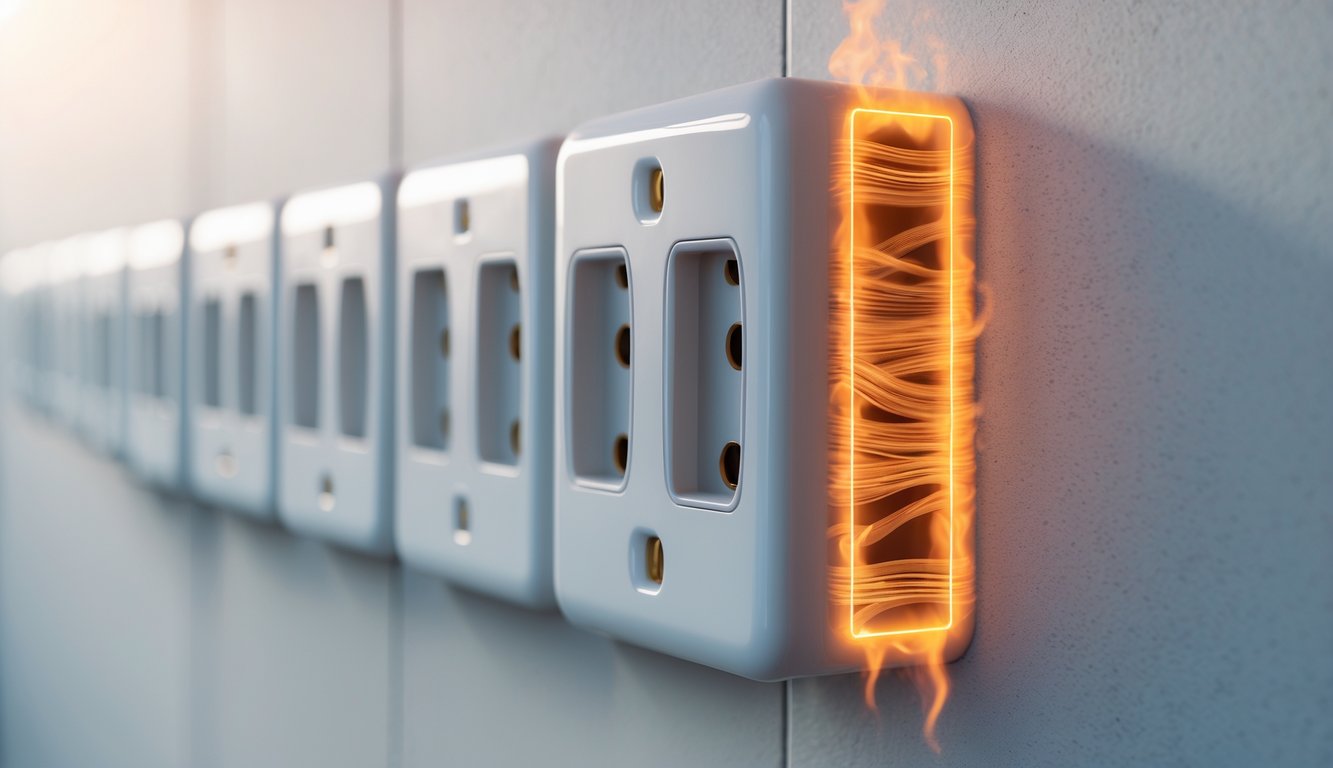
Common Triggers: Overloading and Circuit Issues
Forget the warning label—outlets melt behind bookcases all the time because someone’s charging a phone, tablet, laptop, and who knows what else from one socket. The burnt plastic smell mixed with stale coffee? Classic. Too many devices fighting for one spot, and suddenly you’re in fire hazard territory.
How Overloaded Circuits Cause Heat Buildup
Lamp flickers, then—boom—breaker trips. Overloaded circuits don’t play nice. I plug in three heaters, two monitors, and a fan, and the wires start sweating. The U.S. Fire Administration says overloaded outlets are behind thousands of fires every year; a warm outlet cover isn’t a “feature.”
Heat buildup means too much power for the wiring to handle. Eventually, insulation gets gooey or melts, scorch marks pop up, and there’s that electrical smell. If your outlet’s warm or discolored, shut everything down and call an electrician. Or don’t, and maybe you’ll get a surprise home renovation courtesy of fire.
Using Power Strips and Extension Cords Properly
Four things plugged into a $3 flea market power strip? Disaster. Those things say “15 amps” in tiny letters nobody reads until something smells like smoke. Hair dryers, consoles, space heaters—they all draw more juice than you think. Daisy chaining strips? That’s how you get a bonfire.
Manufacturers aren’t joking about max current. Extension cords? I lost count of how many melted ones I’ve seen because someone thought a 50-foot cord could run a shop vac and a fridge. Tradesafe’s safety guide says plugging high-wattage stuff into the same cord blows fuses—sometimes literally. I did that once. Never again.
Impact of Circuit Breakers and Tripped Outlets
Circuit breakers. Honestly, I used to think they were just another thing to break, but nope—they’re like the grumpy security guard of your house, flipping off the fun the second things get dicey. You hear that click, and suddenly half the house is dark. Not haunted, just the electrical system doing its “not today, Satan” routine to keep the wires from lighting up your drywall like a birthday candle.
Here’s the thing: I once spent what felt like forever chasing a “bad breaker”—spoiler, it was just old, or maybe just moody, I don’t know. Sometimes they trip for no reason, sometimes they refuse when they absolutely should, and then you’re stuck wondering if you should replace them or just move to a cabin in the woods. Want to know why your breaker keeps flipping out? Here’s a link about overloaded circuits. I mean, you could just guess which outlets work, but personally, I’d rather not risk the fire department showing up because I wanted toast and a hairdryer at the same time.
Spotting the Signs of Outlet Overheating
Ever just brush past an outlet and think, “Wait, why’s this thing warm?” Like, am I crazy or is that plastic supposed to feel like a heating pad? People ignore this stuff all the time. I’ve seen outlets with that weird yellowish tint or little scorch marks and everyone’s just, “Eh, must be old paint.” No, it’s not. That’s your wall quietly screaming.
Recognizing a Hot Electrical Outlet
If I touch a wall plate and it’s even a little warmer than the rest of the room, I start side-eyeing every gadget plugged in. Supposedly, outlets shouldn’t get hotter than the air around them—at least that’s what the pros say. If it’s toasty for no reason, something’s wrong. I’m not talking about after you’ve run the space heater for an hour, either. I mean, if it’s still warm when nothing’s plugged in? That’s just sketchy.
From what I’ve read (and heard from a parade of electricians), lingering warmth usually means loose contacts or wires arcing inside. That’s not just a “meh, whatever” moment. It warps the plastic, ruins the outlet, and suddenly your DIY fix turns into an “I hope my insurance covers this” situation. If you want a more official breakdown, here’s a link with photos and warnings.
Flickering Lights and Warning Indicators
Flickering lights. Everyone jokes about ghosts. It’s not ghosts. It’s your wiring throwing a tantrum. I once watched my kitchen lights dim every time the toaster ran (and yes, I kept using the toaster—don’t judge). Usually, that means the outlet’s contacts are loose or the wires can’t keep up. People blame the bulbs, but honestly, it’s probably the outlet trying to retire early.
It’s not just flickering, either. If your GFCI outlet trips for no reason, or your phone charger just stops charging, or things randomly power off—yeah, that’s heat and resistance building up somewhere. If you ever get a whiff of burning plastic or see the outlet warping, just kill the breaker and call someone who knows what they’re doing. Here’s another link with more warning signs.
Burn Marks, Odors, and Other Visual Cues
Why do people ignore burn marks? I mean, if you see brown smudges or smell that “something’s definitely melting” odor, that’s not just old house vibes. That’s insulation frying. I once opened up an outlet and the plastic had just melted itself right onto the screw. Not subtle.
That burnt plastic smell? It lingers, and it’s not the kind of thing you want to get used to. Sometimes the outlet looks fine, but if you see bubbling, yellowing, or anything that makes you go “huh,” it’s probably time to stop plugging things in. This blog has some gnarly photos if you’re into that. And yeah, I’ve seen outlets that technically “worked” right up until they nearly set the wall on fire.